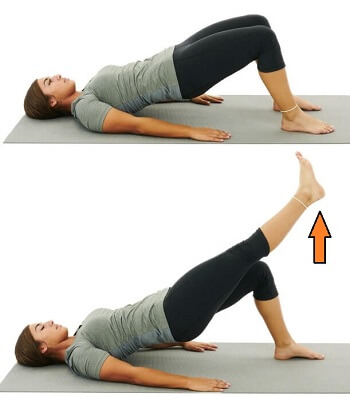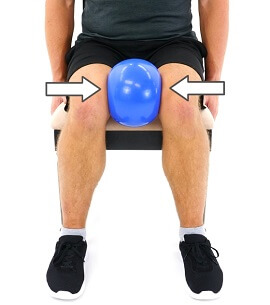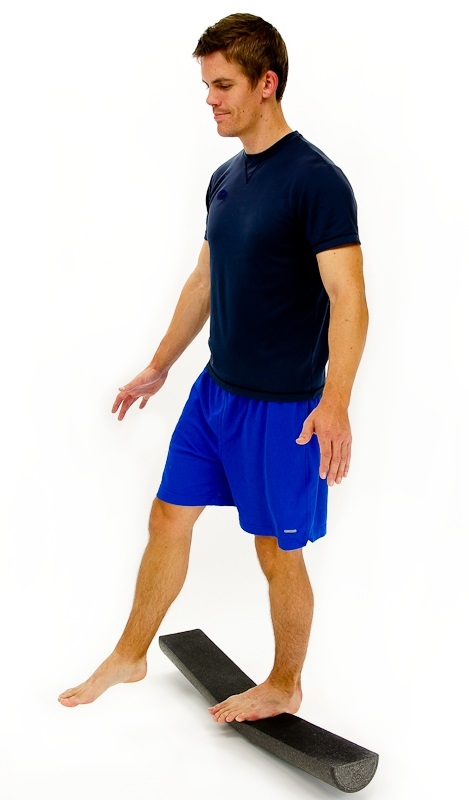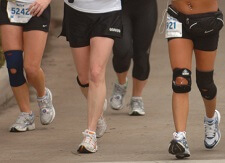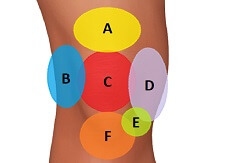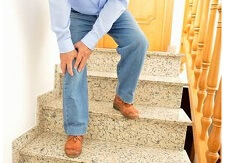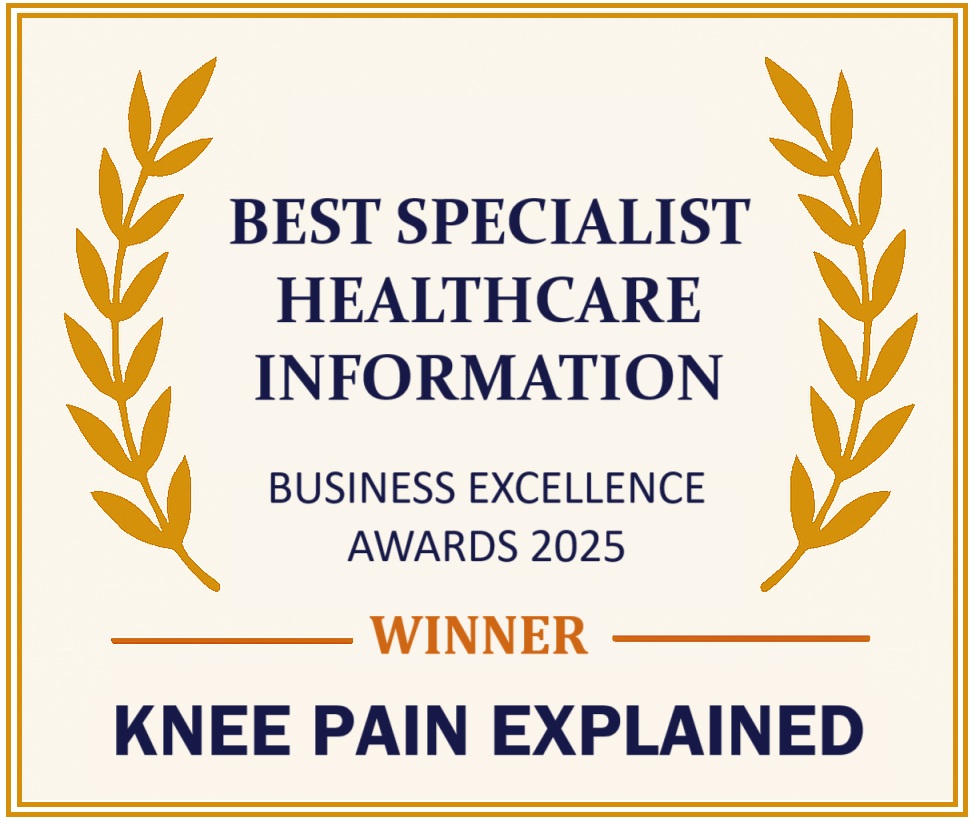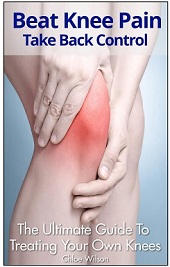- Home
- Knee Exercise Guide
- Strengthening Exercises
- Intermediate
Intermediate Knee
Strengthening Exercises
Written By: Chloe Wilson, BSc(Hons) Physiotherapy
Reviewed by: KPE Medical Review Board

Knee strengthening exercises will help nearly all cases of knee pain and can even prevent knee problems from developing and recurring.
Here we will look at intermediate level strengthening exercises for the knee and leg muscles.
I have grouped these knee strengthening exercises by muscle group: quads, hamstrings, buttocks, kneecap, calves and balance. Pick the ones you find best for you.
If you haven’t already tried the beginners strengthening exercises, I suggest you start there. Once they are feeling easy, come back to these ones. Then, when you have mastered these ones, you can move on to the advanced knee strengthening exercises.
Quads Knee Strengthening
These are the muscles at the front of the thigh that straighten the
knee. Weak quads leads to increased pressure through the knee and knee
cap. Knee strengthening exercises for the quads is one of the most effective ways to
reduce knee pain.
1. Wall Squats
This exercise is a great twist on traditional squats and is one of my all-time favourite knee strengthening exercises. It strengthens the quads but protects the knees.

- Stand with your back against the wall, feet apart, toes pointing forwards
- Slowly slide down the wall a few inches bending your knees. Hold for 3-5 seconds and return to starting position
- Repeat 10-25 times, 2x daily
- Progress the exercise by increasing the depth of the dip or holding the bent knee position for longer (aiming for 10secs)
Top Tip: As you squat, don’t let your knees come too far in or out - Keep your knee in line with your second toe so you can always see your big toe past the inside of your knee
2. Step Ups
This is a great quads knee strengthening exercise that also helps reduce knee pain with stairs.

- Stand facing the bottom of the stairs or a single step. Hold onto the wall/rail for support if required
- Step
up onto the first stair leading with the leg you want to strengthen.
Without turning round, step both feet back down leading with the good
leg
- Repeat 10-30 times, 2x daily
- For more of a challenge 1. Don’t hold onto anything 2. Keep the leg to be worked up on the step and just move the other leg up and down
Top Tip: If you don’t have any steps at home, be creative e.g. telephone directory
3. Step Downs
Step downs help to strengthen the quadriceps, improve balance and improve knee stability.

- Stand sideways on top of a step. Hold the wall/rail for support
- Slowly lower your good leg down to the floor and then bring it back up (keeping your other foot up on the step throughout)
- Repeat 5-20x, 2x daily
- For more of a challenge face forwards and step down instead of sideways, lightly touching the good leg to the floor
Top Tips: 1. You are aiming to do this in a slow, controlled fashion
2. Don’t let the knee twist inwards, keep it in line with your second toe so you can always see your big toe
Hamstring & Glutes Strengthening
The hamstrings and glutes are the muscles on the back of the thigh and the buttock muscles and they often work together. Most people with knee pain have weak glutes, but they are often ignored.
Having weak glutes and hamstrings increases the forces going through the knee. Along with the quads, knee strengthening exercises for the glutes and hamstrings are one of the best ways to reduce pain.
1. The Clam: Stage 2
The Clam is a great way to strengthen the buttock muscles (glutes) which helps support the knee and prevent excessive weight going through the inner side of the knee. It is another one of my favourite knee strengthening exercises as most people have weak glutes. But make sure you can do The Clam Stage 1 first.

- Lie on your side with your hip and knees bent approx 90°, feet together. Lift your feet up about 30cms off the bed, knees still resting on the bed/floor as shown in the middle picture
- Keeping your feet together, lift the top knee up as high as you can. Hold for 3 seconds and slowly lower
- Repeat 10-25x on each side, 2x daily
- For more of a challenge 1. Use a resistance band around your knees to work harder
2. Prop yourself up onto your forearm with your hips raised and then do the clam action
With each of these progressions, start by dropping back to Clam Stage 1
Top Tip: Do not let your top hip roll backwards
2. Bridging: Stage 2
Bridging is a great knee strengthening exercise as it strengthens the hamstrings whilst also working the quads and buttock muscles. Make sure you can do Bridging: stage 1 first.
- Lie on your back with both knees bent about 90° and your feet on the floor/bed
- Clench your buttocks and lift your bottom
off the bed as high as you can without arching your back. Then lift one
leg up. Hold for 3-5 seconds and slowly lower
- Repeat 10-25 times, 1-2x daily
Top Tips: 1. Keep your back straight – don’t let it arch as you lift up, it should be your bottom doing the work
2. Don’t hold your breath – keep breathing normally
3. Don’t let your hips drop during the exercise – keep them up as high as you can
Kneecap Strengthening
Muscle weakness can lead to patella maltracking, where the kneecap doesn’t move properly, which is a common cause of knee pain. Targeted knee strengthening exercises for the muscles that control how the kneecap moves can make a big difference.
1. Kneecap Clenches
Kneecap clenches is the best place to start when it comes to strengthening the muscles on the inside of your knee that are responsible for how the kneecap moves. They also help increase knee stability
- Sit in a chair, feet hip width apart with a soft football in between your knees
- Clench your buttocks, clench your knees and gently squeeze the ball with your knees. Hold for 3-5 secs and relax
- Repeat 10-20x, 2x daily
Top Tips: 1. Feel for the VMO muscle tightening with your fingers
2. When you squeeze the ball, make sure the squeezing movement comes from your knees, not your hips
Calf Strengthening Exercises
The calf muscles are at the back of the leg, below the knee. They help support the knee and co-ordinate knee and ankle movement.
1. Solo Heel Raises
A simple exercise to strengthen the calf muscles to help support the knee

- Stand on one leg holding onto something solid e.g. table or wall for balance.
- Push up onto your tiptoes so your heel is up off the ground as high as you can. Hold for 3-5 secs and slowly lower
- Repeat 10-30 times, 2x daily
When you can do 30 repetitions on a single leg, that is a good sign you have good strength in your calf muscles
Balance Exercises
The knee plays a vital role in ensuring good balance and proprioception. This is often affected when there is knee pain and doesn’t always improve after an injury, even once the pain goes away. This leads to an increased risk of further injury in the future.
As a quick test to see whether you would benefit from balance exercises try standing on one leg with your eyes closed. If you can’t do it for one minute, you’ve got some work to do!
1. One Leg Standing: Stage 2
This exercise helps to improve balance and proprioception and helps your body learn the subtle adjustments needed for good balance.
- Stand with a small rolled
up towel underneath the arch of your foot so you are on an uneven
surface (toes and heel off the floor)
- Lift up your good leg and stand on one leg for as long as you can
- Spend 5 minutes doing this 2x daily
To challenge yourself further:
1. Reach one arm out in different directions
2. Close your eyes
3. Throw and catch a ball
4. Slowly bend and straighten your knee a small amount
Getting the Best Results
Knee strengthening exercises should be challenging, but not painful. The more you do them, the stronger your muscles become and the easier the exercises are. It is important to work at the right level to get the best results without damaging your knee.
If exercises are too easy, they won’t make much difference, if you work muscles too hard, they may cause pain. See our Top tips on getting knee strengthening exercises right section for more info.
You will probably need to do knee strengthening exercises at least four times a week for a month before you notice much of an improvement in your knee pain so stick with it!
If these exercises feel too difficult at the moment, try some beginners strengthening exercises for a few weeks and once your knee is a bit stronger, revisit this section to help you. You may want to mix and match basic and intermediate knee strengthening exercises. Be creative and keep exercising if you want to beat your knee pain!
Once you have mastered these strengthening exercises, CONGRATULATIONS! You are ready to move on to advanced knee strengthening exercises.
Page Last Updated: 15/01/23
Next Review Due: 15/01/25
